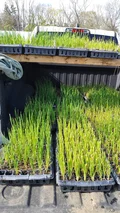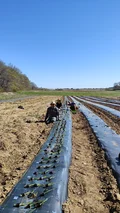TL;DR
Much like yesterday, we planted more onions in the dry field and then put new row cover on the lowest field where the Napa cabbage and Kohlrabi planted a few weeks ago were getting hit by flea beetle hardest.
More New Gear
The new white, long-sleeve breathable hooded shirts have been working out well over the past few days of 70°F plus weather. My only issue with them is that they don’t have pockets, but all field work really needs is a pare of gloves (for working with equiptment), a spear trowel, maybe a water bottle…all optional for someone who’s been doing this a long time. The more water you sip on a hot day, the more likely you’ll have to take a bathroom break, which I prefer to do either before or after going out to a field to work.
I tried my sports-fit boxer briefs yesterday and that was a win. Also, planting on hands and knees really hurts the knees more than it does the back as your back muscles get used to the exercise and stretching. Not so much with my knees. So I ordered a cheap pair of Fiskar workman’s knee pads to try out next week.
Onion Planting
Today, we planted one row of red onions. This took about 2 hours because the person who’s super-fast at planting is working at the Tulip farm for the next month so her time is split between here and there. Her father was a farmer in China and she been planting since she was young. Strong woman, a mama of 3, not a superhero but pretty darn close IMO. Then we went back to the greenhouse and did a little general cleanup before lunch.
Lunch
Tuna salad with cucumbers and celery on my homemade bread. It’s really nice to share a meal with these people.
More Onion Planting
Then we loaded up the truck with yellow onions and went out to plant one more row. This one went a little faster because this time Jamie was able to join us, so there were 4 people on one row. I like to drop which is generally faster than planting. Even though it’s a lot of bending, it’s not down on the knees. But it all has to get done, so after dropping the whole row, I got to planting.
When working together, it’s okay to work on opposite ends and meet in the middle, for instance on a row…but then you don’t have the option of talking with the rest of the crew, which is something this one likes to do. In this case, we played a “which would you rather” game. Things like “would you rather have to eat everything as pills or as blended smoothies” and other goofy stuff to pass the time. As a psychological distraction, it works too…feels more like a bunch of friends doing something together than the monotinous, laborious and lengthy task it could be otherwise. Helps people get to know each other too.
Row Cover and Flea Beetles
After the onions were planted, we went back to the main lower field where the Napa cabbage had been planted a few weeks ago. It showed pretty consistent damage from flea beetles having not had the benefit of row cover which was late to be delivered.
I worry about how much more complicated agriculture is going to get under the current and future policies and disruptions to the supply chain being imposed from above. It’s almost like people in Washington and who seem to be retained by our political system have never worked a physical job day in their adult life, but most of the voters are that and yet we continue to choose from the best of two worst options when we go to the polls. One day isn’t enough. I think a prerequisite to holding any office in our country at every level should be to have to work one year every seven in a minimum wage job that involves manual labor. At least this would keep people from forgetting the context that they should have when in positions of responsibility and power.
On the very opposite end of the size and food chain perspective, the flea beetle doesn’t give a crap about any of that. It’s everywhere, many varieties, in just about every climate, and over-winters in New England. It’s early to come out and attacks early crops. Of course, pesticides aren’t an option on this farm, as they well shouldn’t be anywhere else. So row cover is our primary deterent, but getting that was late to the planting schedule. Even with the partial damage, the starts will most likely recover quickly since the soil fertility in these fields are high thanks to proper land management over the years by Jamie.
Controlling Flea Beetles
I plan to research this (rapidly) more, but for this season it’s doing what is known to work and taking a small hit.
Google says: “Flea beetle control involves a combination of prevention and targeted treatments. Preventative measures include removing weeds, practicing good garden hygiene, and using row covers. Targeted control methods include using sticky traps, applying insecticides (organic or synthetic), and employing biological control agents like nematodes.”
- Remove weeds
- Good garden hygiene
- Row covers
- Starting seeds indoors
- Trap crops
We’re doing 4 of the above 5 things. I haven’t seen trap crops employed yet and will ask about them, and I don’t see too many ‘targeted control methods’ such as sticky traps, Diatomaceous earth, beneficial nematodes, or Surround WP (kaolin clay). But again, each of these things are micro-management responses to a common challenge.
On that note, the other day I was asking about ‘living pathways’ (growing green cover in the walkways between crop rows) and Jamie mentioned that he had tried it in the past, but for a scale like this becomes yet another thing to micro-manage and that it really has to be dialed in otherwise it competes with crop space and resources (water, sun) especially if not mowed regularly. I think for smaller scale than this (such as a market garden), it might make sense, where most of the cultivation and field work is done without machinery, in farms that employ no-till or in other conditions than here. It gave me something to seriously think about, that there are few ‘best practices’ without first really understanding both the land (ecosystem) and your intention (business or footprint) about it.
Well, sufficed to say, we don’t intend for flea beetles to take more than we can stand, and we now have fresh row cover.
How AI Can Help Me Research Flea Beetle Control
I use ChatGPT every so often to compare certain uses with that of my own LLM and RAG homelab setup, particularly in new areas of my implementation when I need ideas and a not-person to bang against. For now, it’s as easy as having a back-and-forth conversation with the app while I’m driving to work (in 5 minutes). Later I’ll go back over and cherry-pick out (no pun intended) what feels like progress or useful further areas to deep-dive into.
For now, this is what my LLM thinks I did today:
Main Themes:
- Farm work and daily activities
- Onion planting and preparation for harvest
- Maintenance of greenhouse and dry field crops
- Pest management (flea beetles)
Activities:
- Watering the greenhouse
- Loading onions onto the truck and continuing onion planting in the dry field
- Seeding summer squash and lettuces in the greenhouse
- Seeding row cover over Napa cabbage to prevent flea beetle damage
- Digging in row cover along edges of the Napa cabbage patch
- Replanting kohlrabi next to the damaged crop
- Removing volunteer seedlings from trays
New Things Not Yet Encountered:
- Elyse onions (a new variety)
Questions and Future Areas of Research:
- Why are flea beetles affecting Napa cabbage so badly? (no specific research mentioned)
- How to manage or prevent volunteer seedlings in the greenhouse (current method is manual removal)
Suggested Actions:
- Investigate more effective methods for removing volunteer seedlings from trays, potentially using technology such as seedling sensors or automated harvesting systems.
- Research optimal timing and conditions for planting Elyse onions, as well as their expected yield and market demand.
- Consider implementing integrated pest management strategies to minimize the impact of flea beetles on Napa cabbage and other crops.
- Evaluate the effectiveness of row cover in reducing flea beetle damage and consider alternative materials or designs.
[end of post]
Enjoy Reading This Article?
Here are some more articles you might like to read next:



